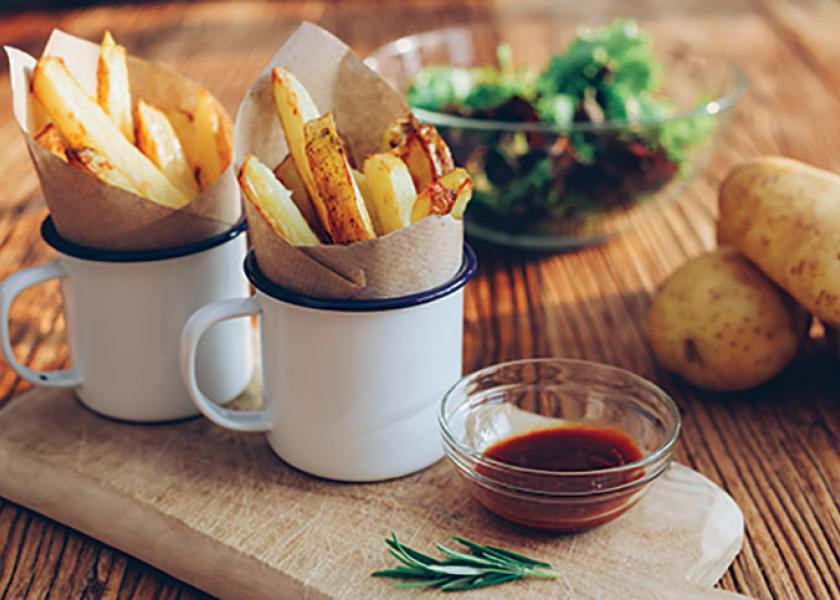Idaho potato industry adjusts to pandemic’s blow to foodservice

Potato sales have taken a big turn toward the retail channel during the current COVID-19 pandemic, and suppliers of Idaho spuds have adapted, says Alan Kahn, vice president of foodservice for the Eagle-based Idaho Potato Commission.
“The demand for potatoes has tilted to retail, and therefore many of these potatoes have been absorbed by the retail markets, as demand for foodservice product dropped,” he said.
In spite of curbs and outright closures of restaurants during the pandemic, the commission has worked to keep potatoes flowing into the foodservice channel, Kahn said.
“We continue to keep in contact with our customers to offer any support needed, be it training, promotional, assistance with menu simplification, new recipes and ideas for restaurant items that are both portable and profitable, etc.,” Kahn said.
The IPC is promoting the idea of “innovative value” to foodservice operators, whereby they can address the delivery and takeout needs with potatoes, while simplifying their menus, continuing to innovate and drive profitability, Kahn said.
“We have even re-started in-person trainings for our distributor customers, as customers will allow, in order to help distributor sales staffs increase their knowledge of Idaho potatoes and be a better resource for their operator customers,” he said.
The commission has modified distributor promotions, as it recognizes “structural changes in the industry and the changes in business dynamics,” and works to “fully support customers’ rebound,” Kahn said.
For example, the commission is conducting webinars with foodservice operators to help them “drive” key issues, such as “simplification, portability, profitability and innovation,” Kahn said, noting that there’s also a new training video for operators that shows them how easy it is to make fresh-cut french fries, which are “very profitable for them.”
The commission also recently developed a training piece on homemade potato chips, which, Kahn notes, also are a profitable item.
“We have also developed a new Recipe Profit Calculator on our website, which helps operators calculate profit and the opportunities with Idaho potatoes,” Kahn said.
“Additionally, we have just started our first foodservice quarterly e-newsletter (The Latest Dish) to help operators improve their business.”
The newsletter, which is currently distributed to more than 5,000 readers, features recipe ideas, storage tips, recipe profit calculator, input from IPC consulting chef Adam Moore and tips for takeout and delivery items, Kahn said.
Kahn noted that more than 100,000 restaurants had closed and there were 3 million fewer foodservice employees now than before the pandemic, but the quick-service category actually was up by 4.9% in the third quarter.
By contrast, the other foodservice segments, such as full-service, were down 21.7% overall in Q3, Kahn said, quoting data from Black Box Intelligence.
Kahn said he didn’t know specifically how the pandemic and resulting closures had affected the fingerling segment, which relies heavily on foodservice.
“What I can tell you is that we are promoting fingerlings in our advertising and in our upcoming 2021 Foodservice Chef Calendar, along with all other varieties,” Kahn said.
“The point here is that Idaho has more than just russets; we have a full complement of specialty varieties.”
The economic fallout of the COVID-19 crisis has drawn comparisons to the 2008 Great Recession, but there are important differences where foodservice is concerned, Kahn said.
“In 2008, people still went out to eat; they just traded down,” he said. “Instead of, say, going to a fine-dining establishment, they may have gone to a casual-dining restaurant or fast-casual operator. Now, 45% of consumers avoid eating out, according to Datassentials.”
He also pointed out that locations weren’t ordered to be closed — or have limited seating — and conventions, cruises, sports venues, trade shows, state fairs, theme parks, schools and other institutions and businesses continued to operate as normal.
“People were still consuming food at those locations,” he said. “People were still taking vacations, but likely traded down. People weren’t scared or nervous about going out to eat. They didn’t fear for their health before — now they do.”
The market for large potatoes took a hit with the closures and curbs in the restaurant sector, but things have been working toward more equilibrium, Kahn said.
“I know at first, early on in the pandemic, some (large potatoes) were moved to the retail channel,” he said.
“Foodservice distributors created partnerships with retailers to keep both inventories moving and keep retailers stocked. I believe the current situation between large potatoes, retail business and foodservice business is in balance, albeit very dynamic from day to day.”
The IPC has used social media to promote Idaho spuds for foodservice consumption, Kahn said. He cited, as examples, the Restaurants Rise Webinar, in which the IPC provided foodservice operators with ideas on improving their business by using Idaho potatoes, which was attended by several hundred operators; and the Kitchen Collaborative — a collaborative effort to develop new items with Idaho potatoes by nationally recognized foodservice chefs. Both have been promoted in social media, Kahn said.
Some schools’ move to online programs has been a blow to institutional sales, Kahn said.
“As you know, many schools, colleges and universities have gone to online learning; this has a significant negative affect on the foodservice business at these locations,” Kahn said.
“The retail potato business in fresh, frozen and dehydrated has been the beneficiary of this, so while people may not be consuming foods in/at school, they still have to eat.”
Related Content:
Good year for spuds in Idaho, marketers say







